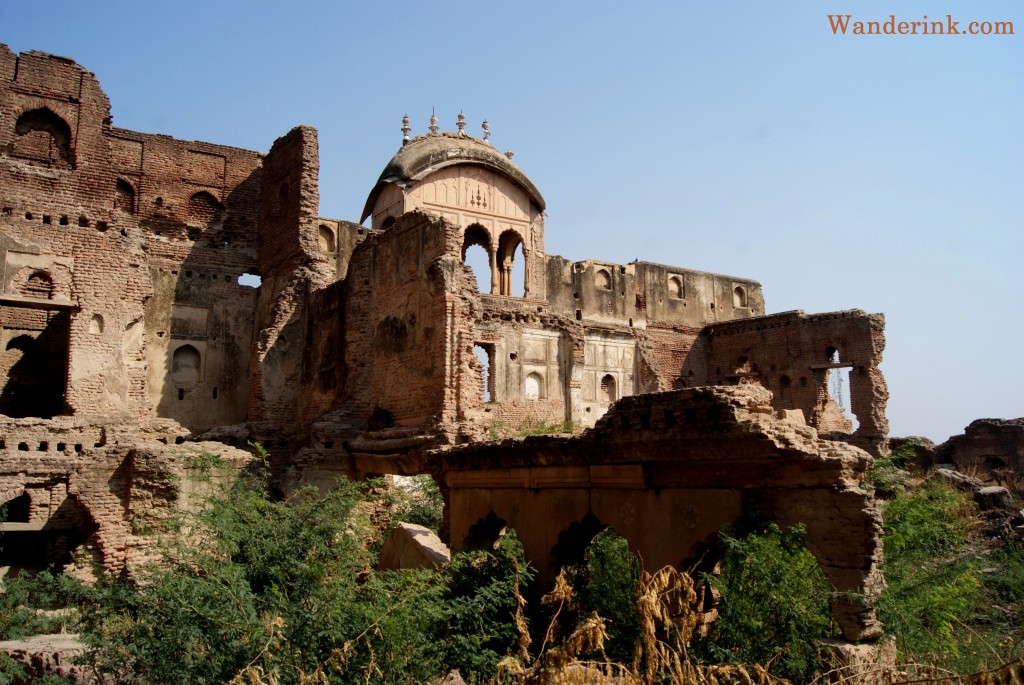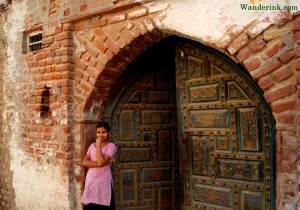All the while I was in Kotwan I couldn’t shrug the queasy over safety of my car. My Red was parked right in the village square – or whatever you call four charpoys arranged in waking disarray under a grandpa tree – and some kids had already discovered the wonderful slide the hood would make. Still. The dusty, deserted place looked like one of those fringe urban settings that it was – 100km from Delhi, along the NH2 – where your car would disappear to one night to emerge a month or two later as a bus or even tractor. Two guys sleeping on the charpoys made me feel only worse for they could be working nights. The gregarious women and old men only made me a bilious bubba for they might be diverting my attention from a chassis getting dismantled. I was paying the price of a splendid curiosity.
What beckons as you drive by along the highway next door are the regal remnants of a gargantuan arched adobe entrance. Lower ramparts ravaged more by time than battle begins to reveal as you follow the sandy thoroughfare that leads into a village. Had it been Agra or Gwalior, the proximity to the fort – or whatever was left of it – would have qualified it for the appellation ‘Lohamandi’. Elaborate floral friezes adorned iron plates bolted onto wooden frames – obviously salvaged from the crumbling fort next door – formed the doors of the brightly coloured houses which opened to a cobbled alley. Uncovered sewages teemed with buzzing mosquitoes, more women and girls (no guys) immersed in different chores of the daily order, electric posts flailed by lines pulling in all directions, stacked up bricks doubling up as support to wizened walls.
From the prying, amused looks you know it is a rarely-beaten track. Friendly folks all of them, an echo of indulgent giggles traced the soft clip-clop of my trekking boots on the stones. The braver one, Vidya, dressed in a billowy green skirt, a man shirt with rolled up sleeves and a loosely draped headgear for the cold – stepped forward. She is pretty in a feisty sort of way and way too amicable. She invited me to tea. But why? Oh because she is from the erstwhile maharaja’s family. Okay, can I see somebody from the ruling line? No, they are all dead. How about the palace then? That you may but beware of the ferocious, snarling guards. More giggles.
Turns out the snarlers are pink-assed as well. Menacing, nevertheless. Monkeys are like us – hate being interrupted when making out. Two ginger steps and I am having second thoughts already. “Son, wait for a while, let them finish their business.” Probably the wisest words I heard in a long time. I looked around. An ancient crouched upon me from out of nowhere; all around was an otherwise empty threnody of a majestic courtyard overrun by thorny bushes. It was definitely a ‘Diwan-I-Am’ or ‘hall of public audience’ with an elevated plinth on which the ruler would have sat, ornamented with stucco work on raised arches that sprang from pillars. Even in the midst of ruins it wasn’t difficult to imagine a dais inlaid with precious stones, next to which the prime minister stood in bowed obeisance and the public farther away awaiting the balm of justice. Or the balance. Obviously there would have been some disgruntled folks as well. Today they were snarling. I stepped out of the time warp – or maybe not – for the ancient was for real.
“The palace belonged to King Seetharam.” He paused to spit paan that arced for a full minute before drizzling down and dripped over quivering lips draped over a toothless mouth. The few tantalising drops that threatened to stain his white vest were rubbed away mercilessly with the back of a strong left. I mistook the pause for effect and uttered a surprised ‘oh’ (‘Really? The Seetharam?’). It was alright for he took no note and went ahead with the legend. Queries like ‘how many years ago did the king live’, ‘was he really a king or a vassal’, ‘how many subjects were in his kingdom’, were all brushed aside with the temerity of brandishing a good story on hand. The king used to bathe in the village pond every day. He used to walk down from his palace carrying his own bathing stool for he didn’t want to sit where the common people sat while they scrubbed themselves. Perfectly plausible if you consider social standings but not if you wonder where did all the scullions go. A roguish smile heralded the take-that bit of the story that was soon to follow: the stool was made of marble and weighed one quintal! See, the king was very health conscious too, so the walk with the stool was also an exercise, he carried it in one hand…like a dumbbell. (Of all the possibilities in the world, or in a hinterland like this, the only public utility I saw was a ‘village health club’. Which understandably made me more restive but explained the ancient calling it a ‘dumbbell.’)
The old man must have lost everything to yet another failed monsoon that year. Or forced to sell his vast tracts for a pittance when land was acquired for the highway or evicted by some builder who wanted to set up another ‘dream home’ for us. Most probably lost a son to jail for boosting cars. Or he was stalling me while the son boosted mine. Vidya appeared like a welcome apparition as against tales revolving around 100kg dumbbells.
“So, did you like my palace?” She asked.
“No, the monkeys didn’t allow him inside.” The ancient chuckled from somewhere around us. “Go on inside, they must be resting now.”
“I think I will have some tea before we go in.” I just wanted to make sure that they would be indeed resting. If I intruded a second time too soon, what if they went ‘fuck it’ and… I wasn’t taking any chances.
Vidya’s family owned four houses in the area – all bequeathed by the maharaja to her ancestors. Yes, everybody used the windows and doors from the palace next door when they built a new house or made an extension to existing ones. Wasn’t it better than let it rot otherwise? No, nobody from the government had ever visited Kotwan with the express desire to restore the palace. (ASI? What was that?) Seetharam was a powerful king who cared deeply for his people. Yes, he was quite a character. She too had heard stories about the one quintal dumbbell/bathing stool.
We went to the palace grounds that were just a stone throw from where Vidya lived. The gnarly monkeys looked very much at peace. Spent-happy. I still allowed Vidya to lead the way; after all it was her ancestral home we were entering. Perfectly domed archways and rusted posterns led to more courtyards overcome with coppice; the entire palace was a labyrinth of stairways and meandering passages that led to nowhere. Vidya gasconaded on her segue on illustrious ancestry which resonated darkly making it difficult to understand. Anyway I wasn’t really listening. Passing by a massive mountain of detritus piled over centuries, I had a vague feeling that we were not alone. Sure enough, shadowing us from over the broken ramparts and crumbling rofous walls was the Galta gang. As Vidya droned on, I looked around for some pebbles, in case Tarak and Rani gave the orders: Attack!
There, on the ground was a strange piece of cut stone, vaguely resembling a linga.
“What’s this?” I asked too intrigued to notice the Galtas closing in.
“Oh, it belonged to my ancestor Maharaja Seetharam who carried it with him when he went to the village pond to take bath. You see, he was my ancestor and very strong…



















Have gone past Kotwan a gazillion times over as many years yet never found the time to stop despite the intrigue it generated. Thanks for demystifying the place through such beautiful expression. Wanderink truly defined. Cheers!
It was the wildest stroke of luck for me…I would’ve just passed by. Dunno, some tug or tweak as if somebody MADE me look in the direction.
looks interesting… thanks for sharing.
This is amazing! I shall certainly visit it next time 🙂
You should!
Thanks Thommen for sharing this destination and story. Goes to my wish list.
Welcome, Anuradha. Right in backyard Delhi.